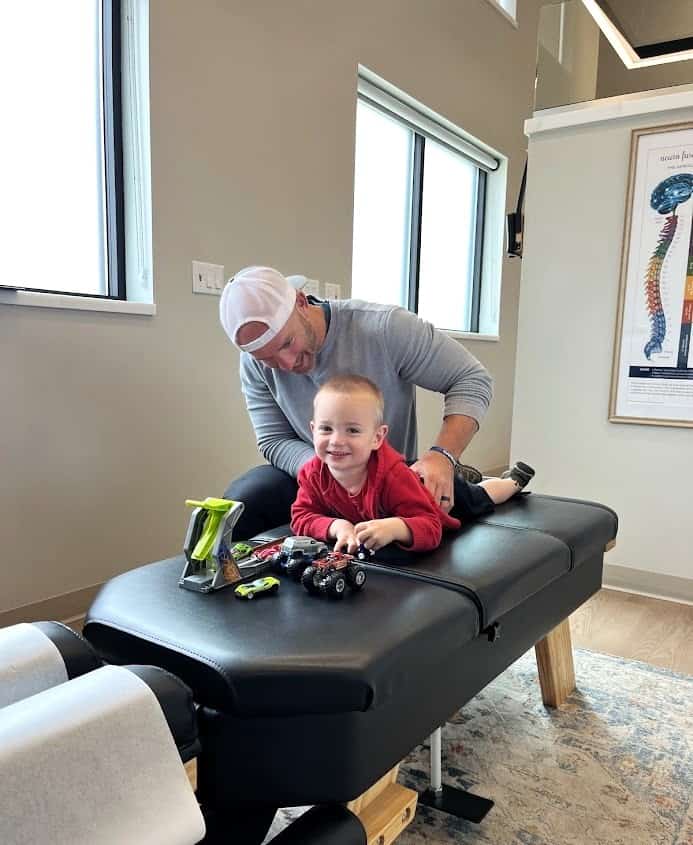It’s the middle of the night. You feel your child’s warm forehead, see the flushed cheeks, and you know something’s going on. Your heart skips a beat as you grab the thermometer and see that number climb. A fever. And just like that, you’re on high alert.
For most parents, fevers feel scary. We’ve been taught they’re something to fear, fight, and fix fast. But what if we told you that fevers are one of the most powerful healing tools your child’s body has?
At Foundations Chiropractic, we take a different view. We don’t see fevers as something dangerous that needs to be shut down—we see them as a neuroimmune superpower.
Let’s walk through what fevers really are, how your child’s nervous system plays a key role in temperature regulation, and why this natural response is something to support—not suppress.
What a Fever Actually Is (And Isn’t)
A fever isn’t just a high number on a thermometer. It’s a coordinated healing response directed by your child’s brain and nervous system. When the body senses a threat—like a virus or bacteria—it sends a signal to the hypothalamus (your internal thermostat) to raise the body’s temperature.
This isn’t random overheating. It’s an intelligent response designed to:
- Slow down pathogen growth
- Boost immune cell activity
- Speed up healing and tissue repair
- Protect healthy cells through heat shock proteins
In short, a fever is your child’s nervous system doing exactly what it’s designed to do.
How the Nervous System Controls Temperature
Your child’s body temperature is managed by the Autonomic Nervous System—the part of the nervous system that also controls breathing, digestion, and heart rate. When this system is in balance, it shifts between the “gas pedal” (Sympathetic Nervous System) and the “brake pedal” (Parasympathetic Nervous System) to regulate heat.
But if there’s dysregulation—something we call dysautonomia—this balance can be thrown off. That’s why some children struggle with chronic low-grade fevers, never spike one at all, or seem to stay sick longer than they should.
The Purpose Behind the Fever
Fevers are often the turning point in healing. They signal that your child’s immune system is awake and working:
- Bacteria and viruses can’t thrive in higher temperatures.
- White blood cells multiply and mobilize faster, helping fight infection.
- Metabolism increases, speeding up the body’s repair work.
- Protective proteins are released, shielding healthy cells from damage.
What we’ve seen clinically (and research backs it up): Kids who are allowed to mount a healthy fever response often recover more completely and quickly.
The “Perfect Storm” That Impacts Fever Patterns
In our office, we often see children who get sick often, struggle to recover, or barely develop a fever when they do. Many times, that’s because their nervous system is stuck in stress mode—or has been from the start.
We call this The Perfect Storm: a combination of prenatal stress, birth trauma, early antibiotic use, and other neurological stressors that interfere with how the brain and immune system communicate.
This can show up as:
- Suppressed or absent fevers
- Prolonged illness
- Overactive or underactive immune responses
The good news? When we address these underlying neurological imbalances, we see fever patterns (and overall immune resilience) improve.
When to Be Cautious With a Fever
Most fevers are safe and helpful—but there are times when medical support is absolutely appropriate. Here’s when to check in with your provider:
- Baby under 3 months old has a fever
- Fever over 102.2°F in a 3–6 month old
- Fever lasting more than 48 hours in a child over 6 months
- Symptoms like extreme fatigue, trouble breathing, refusal to drink fluids, or a rash that won’t fade when pressed
Also important: Febrile seizures, though scary, are usually harmless. They’re a reflection of an immature nervous system, not a dangerous fever itself.
Supporting (Not Suppressing) a Fever at Home
You don’t need to fear your child’s fever—but you can support them through it:
- Keep them hydrated – water, diluted electrolytes, herbal teas, or homemade popsicles
- Let them rest – create a calm, cozy environment
- Dress them lightly – avoid overheating
- Offer gentle nutrition – bone broth, fresh fruits, veggies when they’re ready
These steps help your child feel comforted, without interfering with their body’s healing rhythm.
How Chiropractic Care Helps Support Healthy Fever Responses
Here’s where our care at Foundations makes a big difference.
When we find and gently correct subluxations—areas of tension and interference in the neurospinal system—we’re helping restore the communication between the brain and immune system. This can allow the body to do what it was built to do: heal efficiently, effectively, and fully.
Sometimes, we even see a healthy fever emerge after an adjustment—because the nervous system is finally able to launch the immune response it was trying to start all along.
Our INSiGHT scans help us pinpoint where that dysregulation is happening so we can deliver care that’s precise, safe, and individualized for your child.
Trust the Process. Trust Their Body.
We know it can be hard to stay calm when your child spikes a fever. But with the right knowledge and support, you don’t have to panic. You can trust that this is your child’s beautifully intelligent body doing what it was designed to do.
And if their fever response seems off—or they’re stuck in a pattern of illness—we’re here to help uncover what’s going on beneath the surface.
Want to learn more about how Neurologically-Focused Chiropractic Care can support your child’s immune resilience?
Reach out to us. We’re here to help your child thrive—fever and all.

